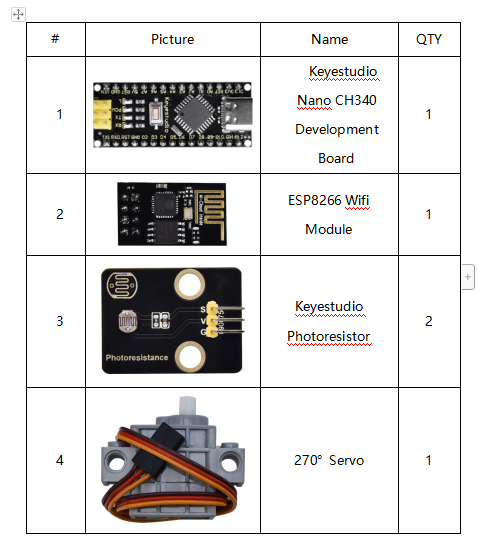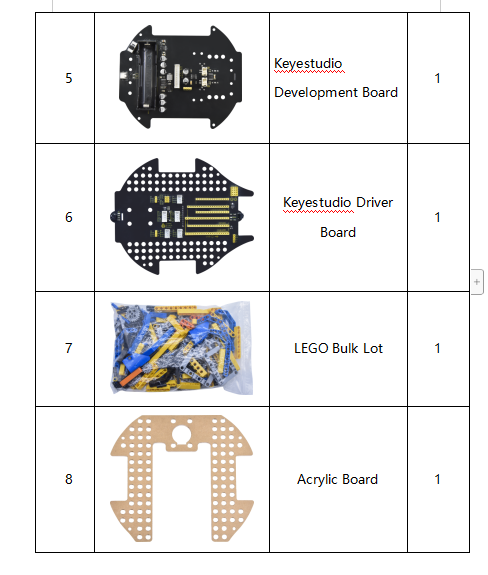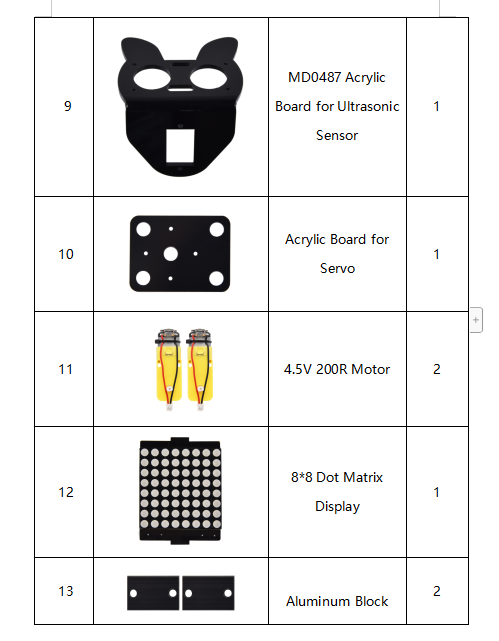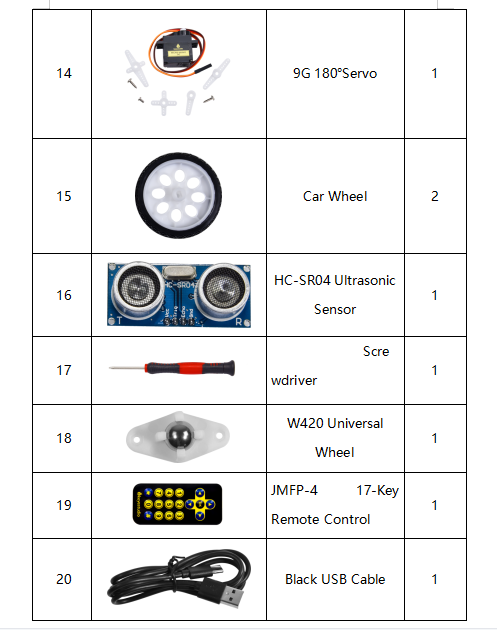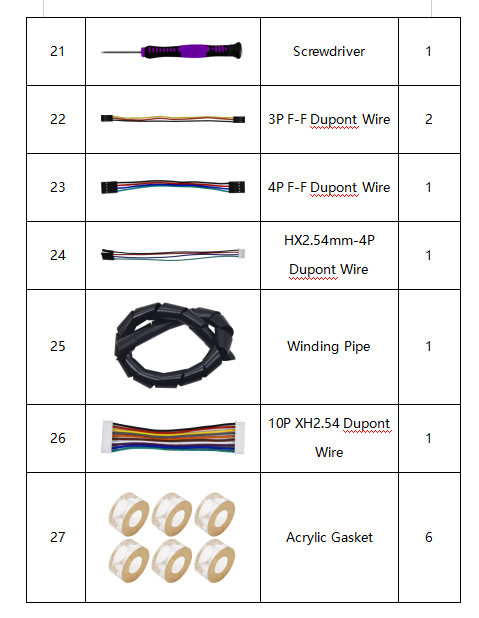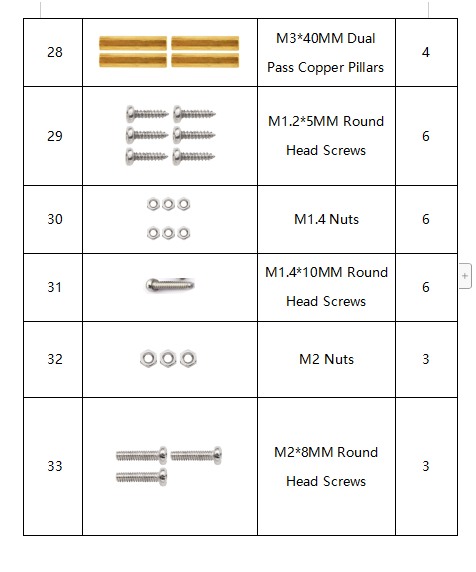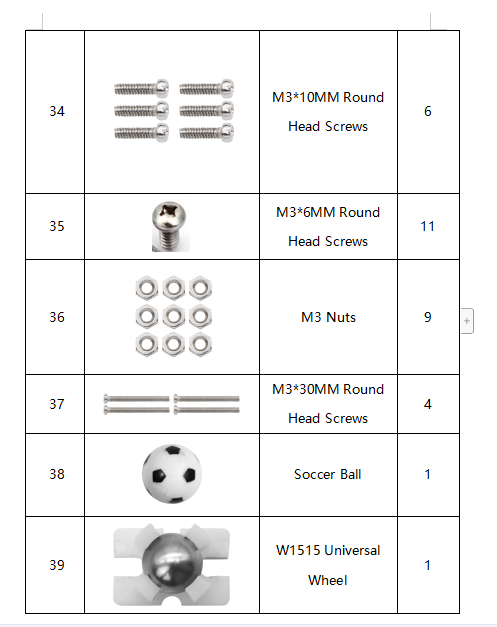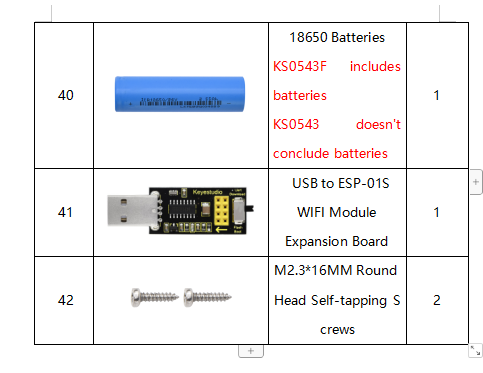KS0543 (KS0543F) Keyestudio Beetlebot 3 in 1 Robot for Arduino STEM Education
Description:
The Beetlebot smart robot, compatible with LEGO building blocks, is a STEM educational product which can automatically dodge obstacles, follow black lines and light to move. Besides, it has three cool forms such as the soccer robot, the siege robot, the handling robot. As for beginners, they can create whatever they want by LEGO building blocks.
Various improvements have been made on the Beetlebot car in comparison with other smart cars. It integrates a motor driver and a large number of sensors and is easy to assemble. Going forward, not only can it impart basic programming knowledge and AI application to children and the youth, but also it can cultivate their creativity, hands-on ability, problem-solving capability, interpersonal communication as well as teamwork ability. With this kit, you have a chance to experience soccer games using your own robots.
Features
- Compatible with LEGO building blocks: generate diverse forms with LEGO blocks and sensors
- Three forms: a soccer robot, a siege engine, a handling robot
- Various functions: Pictures display, atmosphere light control, line tracking, obstacle avoidance, light following , IR control and WIFI control.
- Easy to build: embedded design on car body; wire up the car body with a few steps
- High compatibility: reserve ports for the Raspberry Pico board and the ESP32 control board
- Charging function: integrate a circuit for 18650 batteries, low-cost and effective
- WiFi Control: adopt WiFi control, can finish tailor-made software development
- App: compatible with Android and iOS systems, with aesthetic page and flexible control system
Specification:
- Working voltage: 5V
- Input voltage: 2.5V~4.2V (lithium battery)
- Maximum output current: 3A
- Maximum power consumption: 15W (T=80℃)
- Motor speed: 5V 200 rpm / min
- Motor drive form: dual H-bridge
- Ultrasonic sensing angle: <15 degrees
- Ultrasonic detection distance: 2cm-400cm
- IR control distance: about 7 meters (measured)
- Size: 176mm*137mm*130mm
- Environmental protection attributes: ROHS
Kit List:
Projects
Project 1: LED Blinking
There is an onboard LED (L) on our Arduino Nano board connected to D13. In this experiment, we WILL make this LED blink. LED blinking is the most basic experimental project for Arduino enthusiasts. Let’s get started.
Project 2: 6812 RGB
There are 4 RGB LEDs can be widely used in the decoration of buildings, bridges, roads, gardens, courtyards and so on by colors adjustment.
In this experiment, we will demonstrate different lighting effects with them.
Project 3: Play Music
There is a power amplifier component on the expansion board, which is often used to play music and serve as an external amplifying device for music playback devices.
In this experiment, we use the speaker amplifier component to play music.
Project 4: 8*8 Dot Matrix
Composed of LED emitting tube diodes, the 8*8 LED dot matrix are applied widely to public information display like advertisement screen and bulletin board, by controlling LED to show words, pictures and videos, etc.
Project 5: Servo Rotation
There are two servos on the car. We take the servo connected to pin D9 as an example.
The servo is a motor that can rotate very accurately. It has been widely applied to toy cars, remote control helicopters, airplanes, robots and other fields. In this project, we will use the Nano motherboard to control the servo to spin.
Project 6: Motor Driving and Speed Control
There are many ways to drive motors. This car uses the most commonly used DRV8833 motor driver chip, which provides a dual-channel bridge electric driver for toys, printers and other motor integration applications.
In this experiment, we use the DRV8833 motor driver chip on the expansion board to drive the two DC motors, and demonstrate the effect of forward, backward, left-turning, and right-turning.
Project 7: Ultrasonic Sensor
There is an ultrasonic sensor on the car. It is a very affordable distance-measuring sensor.
The ultrasonic sensor sends a high-frequency ultrasonic signal that human hearing can’t hear. When encountering obstacles, these signals will be reflected back immediately. After receiving the returned information, the distance between the sensor and the obstacle will be calculated by judging the time difference between the transmitted signal and the received signal. It is mainly used for object avoidance and ranging in various robotics projects.
Project 7.1: Ultrasonic Ranging
In this experiment, we use an ultrasonic sensor to measure distance and print the data on a serial monitor.
Project 7.2: Light Following
In the above experiments, we have learned about the 8*8 dot matrix, motor drivers and speed regulation, ultrasonic sensors, servos and other hardware. In this experiment, we will combine them to create a follow car with the ultrasonic sensor. The can can follow an object to move through measuring distance.
Project 7.3: Dodge obstacles
In this project, we will take advantage of the ultrasonic sensor to detect the distance away from the obstacle so as to avoid them.
Project 8: Line Tracking Sensor
There are two IR line tracking sensors on the car. They are actually two pairs of ST188L3 infrared tubes and used to detect black and white lines. In this project, we will make a line tracking car.
Project 8.1: Reading Values
In this experiment, we use ST188L3 infrared tubes to detect black and white lines, then print the data on the serial monitor.
Project 8.2: Line Tracking
We’ve introduced the knowledge of motor drivers, speed regulation, and infrared line tracking. In this experiment, the car will perform different actions according to the values transmitted by the infrared tracking.
Project 9: Light Following
There are two photoresistors on the car. They can vary with the light intensity and send information to the Nano board to control the car.
Photoresistors can determine and conduct the car to move by detecting light.
Project 9.1 Read Values
In this experiment, we will learn the working principle of the photoresistor.
Project 9.2: Light Following Car
We have learned the working principle of photoresistor, motor and speed regulation. In this experiment, we will use a photoresistor to detect the intensity of light as as to achieve the light following effect.
Project 10: IR Remote Control
Infrared remote controls are everywhere in daily life. It is used to control various home appliances, such as TV, speakers, video recorders and satellite signal receivers.
The remote control is composed of an IR emitter, an IR receiver and a decoding MCU. In this project, we will make a IR remote control car.
Project 10.1: IR Remote and Reception
In this experiment, we will combine the IR receiver and the IR remote control to read key values and show them on the serial monitor.
Project 10.2: IR Remote Control Car
In the above experiment, we have learned about the knowledge of the 8*8 dot matrix display, the motor driver and speed regulation, the infrared receiver and the infrared remote control. In this experiment, we will use the infrared remote control and the infrared receiver to control the car.
Project 11: WIFI Control
In this lesson, we control the car through app. The Beetlebot APP sends commanders to the WIFI ESP-01 module then transfers to it to the microcontroller. By doing this, the car can perform different functions.
Project 11.1: WIFI Test
The ESP8266 serial WiFi ESP-01 module is an ultra-low-power UART-WiFi transparent transmission module and designed for mobile devices and IoT applications.
It can achieve networking functions by connecting devices to Wifi internet.
Project 11.2 : Control 8*8 Dot Matrix Display Via WIFI
In this experiment, we will use the ESP8266 serial WIFI ESP-01 module to control the 8*8 dot matrix display on the car through APP and WIFI.
Project 11.3: Multi-purpose Car
In this project we will demonstrate multiple functions of the Beetlebot car through app.
The code of ESP8266wifi module is not changed, then change the wifi password of the code into yours.
Upload the code to the Arduino Nano board, as shown below;
Resources
Download code,libraries and more details, please refer to the following link:
https://fs.keyestudio.com/KS0543
